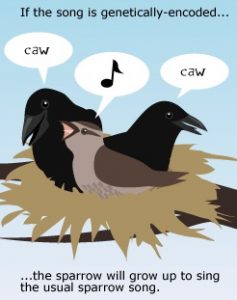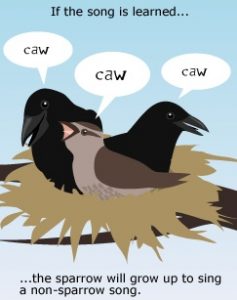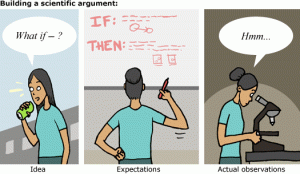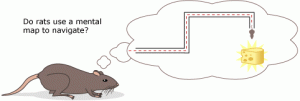1 Nature of Science
Nature of Science
Andrea Bierema
Learning Objectives
- Identify aspects and misconceptions regarding the nature of science and scientific inquiry.
- Describe the processes of science.
- Given a description of an investigation, determine the type of study it is, the research question, and control and experimental variables, when appropriate.
An Introduction to the Nature of Science
To understand what science is, just look around you. What do you see? Perhaps your hand on the mouse, a computer screen, papers, ballpoint pens, the family cat, the sun shining through the window, etc. Science is, in one sense, our knowledge of all that: all the stuff that is in the universe from the tiniest subatomic particles in a single atom of the metal in your computer’s circuits, to the nuclear reactions that formed the immense ball of gas that is our sun, to the complex chemical interactions and electrical fluctuations within your own body that allow you to read and understand these words. But just as importantly, science is also a reliable process by which we learn about all that stuff in the universe. However, science is different from many other ways of learning because of the way it is done. Science relies on testing ideas with evidence gathered from the natural world.
Given the way that science is often taught—memorizing facts from a thick textbook based on research done decades ago and completing lab activities in which there is one known answer—many students have misconceptions about what science is and how it works. Complete the following interactive to learn more about the real side of science!
Exercise
Before beginning the interactive element below, try this!
- Please see this interactive tool that contains a list of statements regarding the nature of science; some correct and some not. Click on a statement and hold down to move the statements around.
- The first thing to do on the website is to put the statements into three groups:
- Agree: Statements that you agree with
- Disagree: Statements that you disagree with
- In between: Statements that you believe to be true under some conditions, but not others.
- Second, once the statements are put into three groups, order the statements from those that you most agree to those that you least agree with. Discuss your list with your peers.
Scientific Practices
The scientific method is too simple to capture the various ways that science occurs, and therefore, we refer to the way science occurs as scientific practices. This section provides more detail on scientific practices, including how it can be explained with a flow chart, that scientific investigations are based on testable research questions and include observations and inferences, and how scientific ideas are tested.
Science Flowchart
As you learned from the activity above, scientists do not follow one Scientific Method. Rather, science is complex. Notice in the flowchart, for instance, that it is non-linear; every study is unpredictable and follows a different path. Moreover, the research is not “done” after one investigation. Results often lead to new questions or new ways to investigate a similar question. Also notice in the flowchart that one of the main elements is “Community Analysis and Feedback.” Science is a social endeavor and scientists talk to each other about their research before, during, and after an investigation is done and even published.
Exercise
At first, the science process, as demonstrated in the science flowchart, might seem overwhelming. Even within the scope of a single investigation, science may involve many different people engaged in all sorts of different activities in different orders and at different points in time—it is simply much more dynamic, flexible, unpredictable, and rich than many other representations. Let’s break it down by looking at an example. The video below explains how an investigation on past climate change fits into the elements of the science flow chart.
Testable Research Questions
Only testable ideas are within the purview of science. For an idea to be testable, it must logically generate specific expectations—in other words, a set of observations that we could expect to make if the idea were true and a set of observations that would be inconsistent with the idea and lead you to believe that it is not true.
Example
Some topics initially appear to be scientific, but actually are not. For example, the Intelligent Design movement promotes the idea that many aspects of life are too complex to have evolved without the intervention of an intelligent cause—assumed by most proponents to be a supernatural being, like God. Promoters of this idea are interested in explaining what we observe in the natural world (the features of living things), which does align well with the aims of science. However, because Intelligent Design relies on the action of an unspecified “intelligent cause,” it is not a testable idea. The Understanding Science website has more information.
A related aspect to being testable is that the question is in regards to the natural world. This includes the components of the physical universe around us like atoms, plants, ecosystems, people, societies, and galaxies, as well as the natural forces at work on those things. In contrast, science cannot study supernatural forces and explanations. For example, the idea that a supernatural afterlife exists is not a part of science because this afterlife operates outside the rules that govern the natural world.
For example:
- When did the oldest rocks on earth form?
- Through what chemical reactions do fungi get energy from the nutrients they absorb?
- What causes Jupiter’s red spot?
- How does smog move through the atmosphere?
Example of a Scientific Question
Question: Is a sparrow’s song genetically-encoded or learned?
Test: See what happens when a sparrow is raised in the nest of another species.
Hypotheses:


Observations and Inferences
We typically think of observations as having been seen “with our own eyes,” but in science, observations can take many forms. Of course we can make observations directly by seeing, feeling, hearing, and smelling, but we can also extend and refine our basic senses with tools: thermometers, microscopes, telescopes, radar, radiation sensors, X-ray crystallography, mass spectroscopy, etc. These tools do a better job of observing than we can! Further, humans cannot directly sense many of the phenomena that science investigates (no amount of staring at this computer screen will ever let you see the atoms that make it up or the UV radiation that it emits) and, in such cases, we must rely on indirect observations facilitated by tools. Through these tools, we can make many more observations much more precisely than those our basic senses are equipped to handle.
Scientific Arguments
Taken together, the expectations generated by a scientific idea and the actual observations relevant to those expectations form what we’ll call a scientific argument.
In this case, the term argument refers not to a disagreement between two people, but to an evidence-based line of reasoning; so scientific arguments are more like the closing argument in a court case (a logical description of what we think and why we think it) than they are like the fights you may have had with siblings.
A scientific argument uses evidence to make a case for whether a scientific idea is accurate or inaccurate. For example, the idea that illness in new mothers can be caused by doctors’ dirty hands generates the expectation that illness rates should go down when doctors are required to wash their hands before attending births. When this test was actually performed in the 1800s, the results matched the expectations, forming a strong scientific argument in support of the idea—and hand-washing!
Scientific arguments involve three components:
![]()

These components are always related in the same logical way:
| 1. What would we expect to see if this idea were true (i.e., what is our expected observation, frequently called predictions)?
2. What do we actually observe that is relevant to those expectations (to be used as evidence)? 3. Do our expectations match our observations? |
Tests typically generate what scientists think of as raw data—unaltered observations, descriptions, or measurements—but those must be analyzed and interpreted. Data become evidence only when they have been interpreted in a way that reflects on the accuracy or inaccuracy of a scientific idea.
For example, an investigation of the evolutionary relationships among crustaceans, insects, millipedes, spiders, and their relatives might tell us the genetic sequence of a particular gene for each organism. This is raw data, but what does it mean? A long series of the As, Ts, Gs, and Cs that make up genetic sequences don’t, by themselves, tell us whether insects are more closely related to crustaceans or to spiders. Instead, that data must be analyzed through statistical calculations, tabulations, and/or visual representations. In this case, a biologist might begin to analyze the genetic data by aligning the different sequences, highlighting similarities and differences, and performing calculations to compare the different sequences. Only then can she interpret the results and figure out whether or not they support the hypothesis that insects are more closely related to crustaceans than to spiders.
Furthermore, the same data may be interpreted in different ways. So another scientist could analyze the same genetic data in a new way and come to a different conclusion about the relationships between insects, crustaceans, and spiders. Ultimately, the scientific community will come to a consensus about how a set of data should be interpreted, but this process may take some time and usually involves additional lines of evidence.
Testing Ideas
Ultimately, scientific ideas must not only be testable but must actually be tested—preferably with many different lines of evidence by many different people. This characteristic is at the heart of all science. Now that we have learned about the complexity of science as a process. let’s explore some of the common ways in which scientists test ideas.
Experimental Studies
An experiment is a test that involves manipulating a variable in a system. In an experiment, some subjects or individuals have the manipulated variable (called an experimental group) and other subjects have the original form of the variable. (called a control group).
Ideally, experiments also involve keeping as many other factors as constant as possible to isolate the cause of the experimental results. Experiments can be quite simple tests set up in a lab—like rolling a ball down different inclines to see how the angle affects the rolling time. But large-scale experiments can also be performed out in the real world. For example, classic experiments in ecology involved removing a species of barnacles from intertidal rocks on the Scottish coast to see how that would affect other barnacle species over time. But whether they are large- or small-scale, performed in the lab or in the field, and require years or mere milliseconds to complete, experiments are distinguished from other sorts of tests by their reliance on the intentional manipulation of some factors and, ideally, keeping others constant.
Observational Studies
Experiments are one way to test some sorts of ideas, but science doesn’t live on experiments alone. For many ideas in science, testing via experiment is impossible, inappropriate, or only part of the picture. In those cases, testing is often a matter of making the right observations. For example, we can’t actually experiment on distant stars in order to test ideas about which nuclear reactions occur within them, but we can test those ideas by building sensors that allow us to observe what forms of radiation the stars emit. Similarly, we can’t perform experiments to test ideas about what T. rex ate, but we can test those ideas by making detailed observations of their fossilized teeth and comparing those to the teeth of modern organisms that eat different foods.
Modeling Studies
In science, the term model can mean several different things, such as an idea about how something works, a physical model of a system that can be used for testing or demonstrative purposes, or a mathematical model (a set of equations that indirectly represents a real system). These equations are based on relevant information about the system and on sets of hypotheses about how the system works.
Given a set of parameters, a model can generate expectations about how the phenomenon will behave in a particular situation. A model and the hypotheses it is based upon are supported when the model generates expectations that match the behavior of its real-world counterpart. In other words, the hypotheses are the potential causes of an observed phenomenon—the phenomenon being the resulting effects of that cause. Therefore, models test cause and effect relationships. Modeling often involves idealizing the system in some way, leaving some aspects of the real system out of the model to isolate particular factors or to make the model easier to work with computationally.
Are Model Organisms Scientific Models?
A model organism is a non-human species that has been widely studied, usually because it is easy to maintain and breed in a laboratory setting and has particular experimental advantages. For example, they may have particularly robust embryos that are easily studied and manipulated in the lab, which is useful for scientists studying development. Or, they may occupy a pivotal position in the evolutionary tree; this is useful for scientists studying evolution.
If a study uses a model organism, is it a modeling study? The answer may seem like an obvious “yes”, but consider how modeling organisms are used. For instance, what if the modeling organism is used in an experimental design in which some individuals are part of an experimental group and others are in a control group. The purpose of doing the research may be ultimately to predict how the treatment may affect humans, but what is the research question? The research question is “how does treatment x affect this model species?” Scientists then use that information to infer how the treatment might affect humans, but it cannot by itself actually answer the question of how humans will be impacted. Instead, it is inferred how humans may be impacted based on prior research that connects physiological similarities and differences between the model species and humans.
Therefore, when asking if a study is a modeling study, do not assume it is because it is using a model species. Rather, consider what the research question is, not just the general purpose of doing the research.
Exercise
Now try applying what you have learned about scientific research to an investigation!
Science Checklist
To conclude this introduction to the nature of science, we’ll look at a checklist that summarizes key characteristics of science and compare it to an “atypical” example of science to see how they measure up and which characteristics they share.
This checklist provides a guide for which sorts of activities are encompassed by science, but since the boundaries of science are not clearly defined, the list should not be interpreted as all-or-nothing. Some of these characteristics are particularly important to science (e.g., all of science must ultimately rely on evidence), but others are less central. For example, some perfectly scientific investigations may run into a dead-end and not lead to ongoing research. Use this checklist as a reminder of the usual features of science. If something doesn’t meet most of these characteristics, it shouldn’t be treated as science.
Science Checklist
How scientific is it?
- Focuses on the natural world
- Aims to explain the natural world
- Uses testable ideas
- Relies on evidence
- Involves the scientific community
- Leads to ongoing research
- Benefits from scientific behavior
Example Case Study:
Most of us have probably wondered how other animals think and experience the world (e.g., is Fido really happy to see me or does he just want a treat), but can that curiosity be satisfied by science? After all, how could we ever test an idea about how another animal thinks? In the 1940s, psychologist Edward Tolman investigated a related question using the methods of science. He wanted to know how rats successfully navigate their surroundings—for example, a maze containing a hidden reward. Tolman suspected that rats would build mental maps of the maze as they investigated it (forming a mental picture of the layout of the maze), but many of his colleagues thought that rats would learn to navigate the maze through stimulus-response, associating particular cues with particular outcomes (e.g., taking this tunnel means I get a piece of cheese) without forming any big picture of the maze.

Here’s how Tolman’s investigation measures up against our checklist:
So is it science? Though less stereotypically scientific than splitting atoms, this psychological research is very much within the realm of science.
Attributions
This chapter is a modified derivative of the following articles:
Understanding Science. 2020. University of California Museum of Paleontology. 11 June 2020 <http://www.understandingscience.org>.
“What are Model Organisms?” by Yourgenome, Genome Research Limited is licensed under CC BY 4.0 License.
Media Attributions
- Scientific Method © University of California Museum of Paleontology's Understanding Science
- Song sparrow1 © University of California Museum of Paleontology's Understanding Science
- Song sparrow2 © University of California Museum of Paleontology's Understanding Science
- Scientific Argument © Andrea Bierema
- building a scientific argument © Understanding Science. University of California Museum of Paleontology
- Testing an Idea1 © Understanding Science. University of California Museum of Paleontology
Our knowledge of the natural world and the process through which that knowledge is built. The process of science relies on the testing of ideas with evidence gathered from the natural world. Science as a whole cannot be precisely defined but can be broadly described by a set of key characteristics. To learn more, visit A science checklist.
In science, an observation or experiment that could provide evidence regarding the accuracy of a scientific idea. Testing involves figuring out what one would expect to observe if an idea were correct and comparing that expectation to what one actually observes.
Test results and/or observations that may either help support or help refute a scientific idea. In general, raw data are considered evidence only once they have been interpreted in a way that reflects on the accuracy of a scientific idea.
All the components of the physical universe — atoms, plants, ecosystems, people, societies, galaxies, etc., as well as the natural forces at work on those things. Elements of the natural world (as opposed to the supernatural) can be investigated by science.
An idea that is often thought to be true but is actually incorrect.
Capable of being tested scientifically. An idea is testable when it logically generates a set of expectations about what we should observe in a particular situation. Ideas that are not testable cannot be investigated by science.
Not of the natural world. Supernatural entities, forces, and processes cannot be studied with the methods of science. To learn more, visit What's natural?
To note, record, or attend to a result, occurrence, or phenomenon. Though we typically think of observations as having been made "with our own eyes," in science, observations may be made directly (by seeing, feeling, hearing, tasting, or smelling) or indirectly using tools.
A logical description of a scientific claim and the evidence for or against it. In everyday language, an argument usually means a verbal disagreement, but here we use another meaning of the term: a reasoned case for or against a particular viewpoint. Scientific arguments generally have a few basic components: What is the claim? What is the evidence that supports the claim, and why does the evidence support that claim?
In science, a potential outcome of a scientific test that is arrived at by logically reasoning about a particular scientific idea (i.e., what we would logically expect to observe if a given hypothesis or theory were true or false). The expectations generated by an idea are sometimes called its predictions. Observations that match the expectations generated by an idea are generally interpreted as supporting evidence. Mismatches are generally interpreted as contradictory evidence.
In science, a possible outcome of a scientific test based on logically reasoning about a particular scientific idea (i.e., what we would logically expect to observe if a particular idea were true or false). This website generally uses the term expectation in place of prediction.
A scientific test that involves manipulating some factor or factors in a system in order to see how those changes affect the outcome or behavior of the system. Experiments are important in science, but they are not the only way to test scientific ideas.
In scientific testing, a group of individuals or cases that receive the experimental treatment or factor. Experimental groups can be contrasted with control groups.
In scientific testing, a group of individuals or cases matched to an experimental group and treated in the same way as that group, but which is not exposed to the experimental treatment or factor that the experimental group is. Control groups are especially important in medical studies in order to separate placebo effects from outcomes of interest. Control groups are sometimes also called control treatments or simply controls. This can be confusing since this use of the term is slightly different from what we mean when talking about controlled variables.
In scientific testing, to keep a variable or variables constant so that the impact of another factor can be better understood.
In science, the term model can mean several different things (e.g., an idea about how something works, a physical model of a system that can be used for testing or demonstrative purposes, or a mathematical model, which is set of equations that indirectly represents a real system). These equations are based on relevant information about the system and on sets of hypotheses about how the system works. Given a set of parameters, a model can generate expectations about how the system will behave in a particular situation. A model and the hypotheses it is based upon are supported when the model generates expectations that match the behavior of its real-world counterpart. Modeling often involves idealizing the system in some way — leaving some aspects of the real system out of the model in order to isolate particular factors or to make the model easier to work with computationally.
A non-human species that has been widely studied and is used in experiments to make predictions on how variables may impact humans.
To figure out through logical reasoning. Inferences are often based on established knowledge and/or assumptions.


